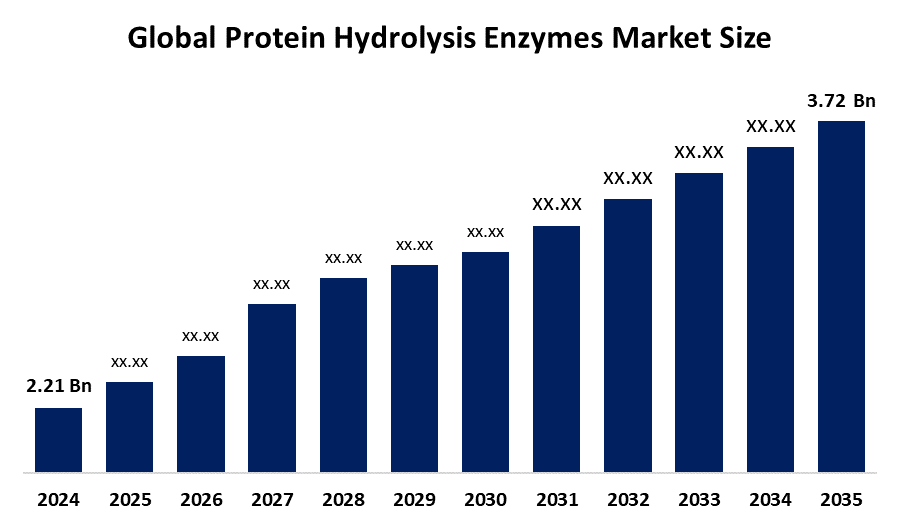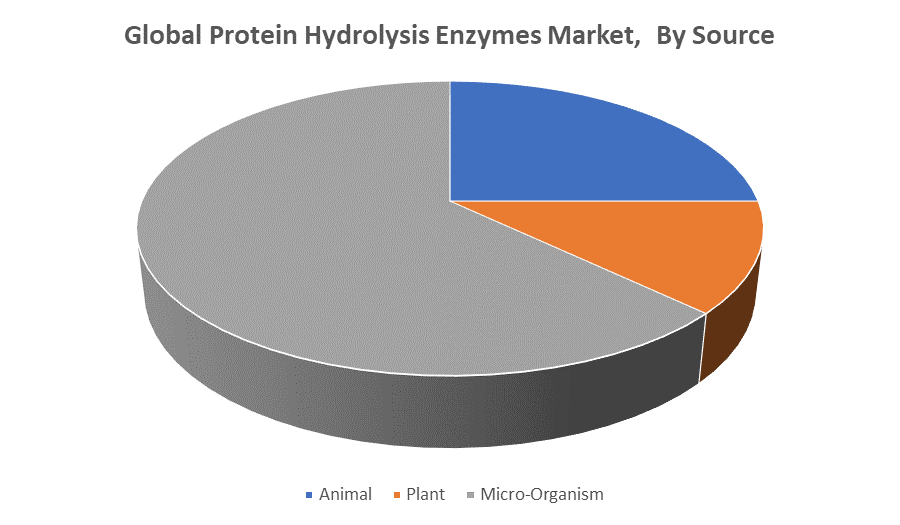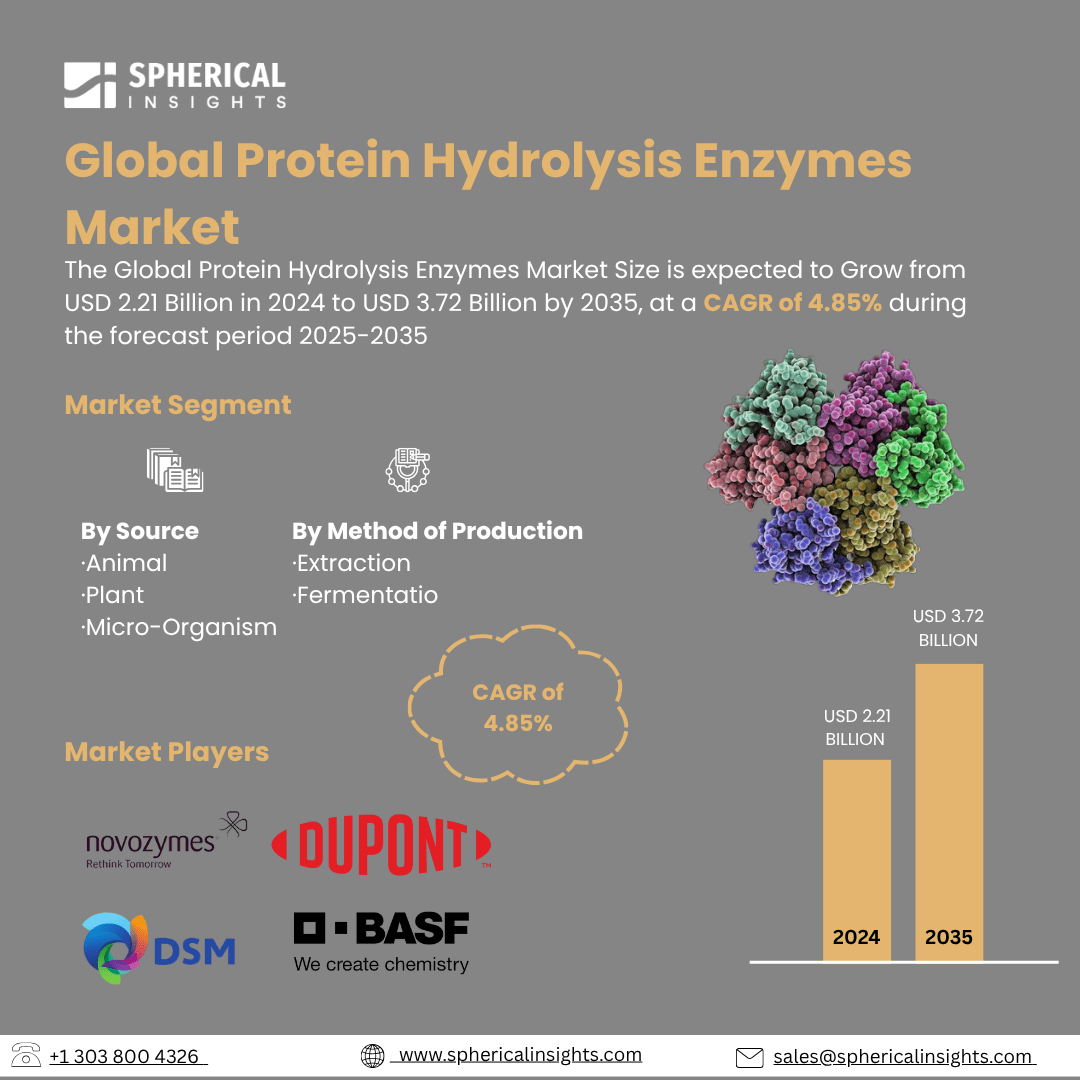Global Protein Hydrolysis Enzymes Market Insights Forecasts to 2035
- The Global Protein Hydrolysis Enzymes Market Size Was Estimated at USD 2.21 Billion in 2024
- The Market Size is Expected to Grow at a CAGR of around 4.85% from 2025 to 2035
- The Worldwide Protein Hydrolysis Enzymes Market Size is Expected to Reach USD 3.72 Billion by 2035
- Asia Pacific is expected to grow the fastest during the forecast period.

Protein Hydrolysis Enzymes Market
The protein hydrolysis enzymes market involves the production and application of enzymes that catalyze the breakdown of proteins into peptides and amino acids. These enzymes, primarily proteases such as trypsin, pepsin, and papain, are essential in various industries including food and beverages, pharmaceuticals, animal feed, and biotechnology. In food processing, they are used for improving texture, flavor, and nutritional properties of protein-rich products. In pharmaceuticals, they assist in drug development and therapeutic formulations, while in animal nutrition, they enhance feed digestibility and protein absorption. The market covers both natural and microbial enzyme sources and includes products tailored for specific industrial processes. Protein hydrolysis enzymes contribute to improving efficiency, reducing processing time, and enhancing the quality of end products. With a broad range of applications and benefits, these enzymes are integral to many production systems that rely on precise protein modification, making them a key component in modern industrial and scientific operations.
Attractive Opportunities in the Protein Hydrolysis Enzymes Market
- The demand for specialized solutions in food, pharmaceuticals, and biotechnology presents an opportunity for enzyme manufacturers to develop customized formulations. Tailored enzymes can enhance the digestibility and functionality of plant-based proteins or optimize drug formulations. This trend allows companies to differentiate their products and meet industry-specific needs, driving both innovation and growth.
- Enzyme-based therapies offer solutions for digestive disorders and metabolic diseases by improving nutrient absorption. This opens up opportunities for enzyme applications in medical nutrition, where tailored enzymes can support personalized health treatments. As the focus on digestive health and functional foods increases, enzyme companies can tap into the expanding medical nutrition market.
- Waste valorization presents an opportunity to turn food and agricultural waste into valuable products using protein hydrolysis enzymes. These enzymes can transform waste into protein hydrolysates for use in fertilizers, cosmetics, and bioactive compounds. This sustainable approach not only reduces waste but also creates eco-friendly, high-value products, aligning with global sustainability goals.
Global Protein Hydrolysis Enzymes Market Dynamics
DRIVER: Rising consumer demand for high-protein
The growth of the protein hydrolysis enzymes market is driven by several key factors. Rising consumer demand for high-protein and easily digestible food products has led to increased use of these enzymes in the food and beverage industry, particularly in sports nutrition, infant formula, and functional foods. The shift toward clean-label and natural ingredients has further boosted the adoption of enzymatic processes over chemical methods. In the pharmaceutical and biotechnology sectors, the need for efficient protein modification and drug formulation supports enzyme usage. Additionally, the animal feed industry is leveraging these enzymes to improve nutrient absorption and feed efficiency. Technological advancements in enzyme engineering and production have enhanced the specificity, stability, and cost-effectiveness of protein hydrolysis enzymes, encouraging broader application. Furthermore, growing awareness of environmental sustainability is prompting industries to adopt enzymatic solutions that offer lower energy consumption and reduced chemical waste, reinforcing the market’s positive trajectory across multiple sectors.
RESTRAINT: High production cost of enzymes
One of the primary challenges is the high production cost of enzymes, particularly those requiring advanced fermentation and purification processes, which can limit their affordability for small and medium-sized enterprises. Additionally, the stability and activity of enzymes can be affected by processing conditions such as pH, temperature, and substrate type, potentially reducing efficiency in industrial applications. Regulatory concerns and compliance with food safety standards also pose challenges, as approval processes for enzyme use in food and pharmaceuticals can be time-consuming and costly. Limited awareness and technical expertise in some end-user industries may further restrict adoption. Moreover, the availability of alternative protein processing methods, such as chemical hydrolysis, may compete with enzymatic approaches in certain applications. Together, these factors can slow market expansion, especially in regions or industries with limited infrastructure or investment in biotechnological innovation.
OPPORTUNITY: Development of customized enzyme solutions tailored to specific industrial needs
One key opportunity lies in the development of customized enzyme solutions tailored to specific industrial needs, such as targeted hydrolysis for novel food textures or specialized pharmaceutical formulations. The rise of plant-based and alternative proteins creates demand for enzymes that can enhance the functionality and digestibility of non-animal protein sources. Additionally, expanding research in medical nutrition, such as enzyme-based therapies for digestive disorders or metabolic diseases, opens new avenues for application. Innovations in enzyme immobilization and delivery systems offer potential for improved enzyme stability and reusability, making processes more cost-effective and sustainable. There's also growing potential in waste valorization, where enzymes are used to convert food or agricultural waste into valuable protein hydrolysates for use in fertilizers, cosmetics, or bioactive compounds. These novel applications present significant opportunities for market players to diversify and expand their offerings in high-value segments.
CHALLENGES: The complexity of optimizing enzyme activity across diverse substrates and process conditions
One major challenge is the complexity of optimizing enzyme activity across diverse substrates and process conditions, which requires extensive R&D and precise formulation strategies. Maintaining consistent enzyme performance in large-scale operations can also be difficult due to batch variability and raw material inconsistencies. Another challenge is the scalability of innovative enzyme technologies from laboratory to industrial production, which often involves high costs and technical hurdles. Intellectual property issues and patent restrictions may limit access to certain enzyme technologies or formulations, posing barriers for new entrants. Additionally, competition among enzyme manufacturers can lead to pricing pressures, affecting profitability. Ensuring the long-term stability and shelf life of enzyme-based products, especially in regions with limited cold-chain logistics, is another technical challenge. Addressing these operational and strategic issues is essential for sustained growth and innovation in the protein hydrolysis enzymes market.
Global Protein Hydrolysis Enzymes Market Ecosystem Analysis
The global protein hydrolysis enzymes market ecosystem includes raw material suppliers, enzyme manufacturers, technology providers, distributors, regulatory bodies, end-use industries, and research institutions. Enzymes are developed using microbial, plant, or animal sources and applied in food, pharmaceuticals, animal feed, and biotech. Regulatory agencies ensure compliance, while logistics providers manage global distribution. Research institutions drive innovation, and consumer demand influences product development. This interconnected network supports the market's growth, efficiency, and adaptation to evolving industry needs and technological advancements.
Based on the source, the micro-organism segment dominated the largest market revenue share over the forecast period

The micro-organism segment held the largest market revenue share in the global protein hydrolysis enzymes market over the forecast period. This dominance is primarily attributed to the high efficiency, scalability, and cost-effectiveness of microbial enzymes such as proteases derived from bacteria (e.g., Bacillus species) and fungi (e.g., Aspergillus species). These enzymes are widely used across food processing, pharmaceuticals, and animal feed industries due to their consistent activity, adaptability to industrial conditions, and ease of genetic modification, making them a preferred choice over plant or animal-derived enzymes.
Based on the method of production, the fermentation segment dominated the market with a revenue share during the forecast period

The fermentation segment dominance is due to the cost-effectiveness, scalability, and efficiency of fermentation processes, which allow for large-scale production of high-quality enzymes. Fermentation enables the growth of microorganisms such as bacteria and fungi that produce proteases in controlled environments, offering consistent enzyme activity and a reliable supply. Additionally, biotechnological advancements in fermentation techniques have improved enzyme yield and reduced production costs, further driving the widespread adoption of fermentation-derived enzymes in industries such as food, pharmaceuticals, and animal feed.
North America is anticipated to hold the largest market share of the protein hydrolysis enzymes market during the forecast period
North America is expected to hold the largest market share in the global protein hydrolysis enzymes market during the forecast period. The region leads due to strong demand from industries such as pharmaceuticals, food, and detergents. Growth is driven by the increasing use of enzymatic processes for producing functional foods, bioactive peptides, and environmentally friendly cleaning products. Additionally, ongoing technological advancements and a well-established industrial infrastructure support North America’s dominant position, making it a key market player in the global protein hydrolysis enzymes industry.
Asia Pacific is expected to grow at the fastest CAGR in the protein hydrolysis enzymes market during the forecast period
Asia Pacific is projected to experience the fastest growth in the global protein hydrolysis enzymes market during the forecast period. This growth is driven by factors such as rapid industrialization, increasing demand for enzyme-based products across various sectors, and significant advancements in the food and beverage, pharmaceutical, and biotechnology industries. Countries like China and India are witnessing a surge in the adoption of protein hydrolysis enzymes for applications ranging from food processing to drug development. The region's expanding industrial base and growing consumer awareness further contribute to the market's expansion. As a result, Asia Pacific is anticipated to lead in both market growth and innovation in the protein hydrolysis enzymes sector.
Recent Development
- In May 2024, Fermbox Bio launched EN3ZYME, a cutting-edge enzyme cocktail designed to enhance the efficiency and cost-effectiveness of transforming pre-treated agri-based residues into fermentable sugars, facilitating the production of second-generation ethanol and bio-ingredients.
Key Market Players
KEY PLAYERS IN THE PROTEIN HYDROLYSIS ENZYMES MARKET INCLUDE
- Novozymes A/S
- DuPont de Nemours, Inc. (Danisco)
- DSM (Royal DSM)
- BASF SE
- Chr. Hansen Holding A/S
- Amano Enzyme Inc.
- AB Enzymes
- Biocatalysts Ltd.
- Kerry Group
- Evolva Holding SA
- Others
Market Segment
This study forecasts revenue at global, regional, and country levels from 2020 to 2035. Spherical Insights has segmented the protein hydrolysis enzymes market based on the below-mentioned segments:
Global Protein Hydrolysis Enzymes Market, By Source
- Animal
- Plant
- Micro-Organism
Global Protein Hydrolysis Enzymes Market, By Method of Production
Global Protein Hydrolysis Enzymes Market, By Regional Analysis
- North America
- Europe
- Germany
- UK
- France
- Italy
- Spain
- Russia
- Rest of Europe
- Asia Pacific
- China
- Japan
- India
- South Korea
- Australia
- Rest of Asia Pacific
- South America
- Brazil
- Argentina
- Rest of South America
- Middle East & Africa
- UAE
- Saudi Arabia
- Qatar
- South Africa
- Rest of the Middle East & Africa






